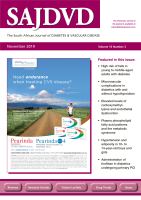

VOLUME 16 NUMBER 2 • NOVEMBER 2019
47
SA JOURNAL OF DIABETES & VASCULAR DISEASE
FROM THE EDITOR’S DESK
From the Editor’s Desk
Correspondence to: FA Mahomed
Head of Internal Medicine, Madadeni Hospital
Newcastle, KwaZulu-Natal
T
his issue of the journal deals with a variety of topics, from
the risk of falls in diabetic people to endothelial dysfunction
and tirofiban use in percutaneous transluminal coronary
angioplasty.
Hlayisi and colleagues (page 48) studied the risk of falls in
young to middle-aged patients with diabetes compared with non-
diabetic subjects. They demonstrated a high risk of falls in the
diabetics, which was exacerbated by symptoms such as peripheral
neuropathy and visual difficulties. Longer duration of diabetes
as well as uncontrolled glycaemic status also increased the risk
of falling. They highlight the need to assess fall risk in young to
middle-aged patients with diabetes and suggest early intervention
and rehabilitation, as well as health education to prevent falls. While
fall risk in older patients is well described,
1
these authors point to
a younger group of patients that is also at risk. Interventions such
as balance training
2
and the use of video games
3
have been tried.
Previous reports have suggested an association between
hypothyroidism and macrovascular complications. Johnson and
Rayner (page 53) studied microvascular complications in patients
with type 2 diabetes and hypothyroidism. They found no clear
association between microvascular disease and hypothyroidism
but found a doubling of cardiovascular disease risk. This finding is
consistent with other studies.
4
The mechanism involved may be due
to the increase in insulin resistance found in hypothyroidism
5
and its
cardiovascular sequelae.
In the Ellisras Longitudinal Study 2017, Mogale
et al.
(page 57)
found an association between major types of serum advanced
glycation end-products (AGEs) and endothelial dysfunction in black
patients with type 2 diabetes. AGEs are associated with vascular
dysfunction and accelerated atherosclerosis in several ways,
6
with
effects on collagen links and nitric oxide levels, and with cellular
receptor activation. This causes extensive vascular disease and
understanding the mechanisms involved may help to identify
therapeutic targets to reduce this vascular risk in patients with
diabetes.
Diets rich in
n
-6 polyunsaturated fatty acids (PUFAs) and
saturated fatty acids have been associated with increased risk of
obesity and the metabolic syndrome, whereas diets high in
n
-3
long-chain PUFAs are associated with lower risk. Ojwang and
co-workers (page 62) investigated the association of dietary fatty
acids and plasma phospholipid fatty acid patterns with measures
of adiposity and the metabolic syndrome. They identified certain
fatty acid patterns that provided possible protective associations
with adiposity and the metabolic syndrome in a South African
setting, whereas other fatty acid patterns were associated with
adiposity and the metabolic syndrome. With rapid urbanisation and
changing diets, both fat content and fat percentage of the diet are
having an impact on the health of populations.
7
Plasma free fatty
acids may contribute to cardiovascular disease by disturbing insulin
sensitivity and may induce low-grade inflammation.
8
As part of the Ellisras Longitudinal Study 2017, Chungag et
al. (page 72) evaluated the prevalence of hypertension in a group
of 10- to 14-year-old girls and boys to determine the association
between blood pressure and measures of adiposity. Levels of
hypertension and pre-hypertension were 20 and 12%, respectively,
and systolic blood pressure was associated with increasing levels
of adiposity. This highlights the importance of weight-control
strategies for the prevention of hypertension in adolescents. Not
only is there a physical risk to health, but psychosocial factors
also come into play. Weight-control strategies in this age group
are well described,
9
but have proved difficult to implement on a
population level. Conservative weight-loss measures have had only
a modest effect and some studies suggest a better outcome with
early bariatric surgery.
10
Ghonim and colleagues (page 76) evaluated the safety and
effectiveness of intracoronary versus intravenous administration of
a thrombolytic, tirofiban, in diabetic patients with acute ST-segment
elevation myocardial infarction, during primary percutaneous
coronary intervention. There was benefit in the intracoronary
administration in several outcome measures, when compared
to intravenous administration. The major adverse cardiac events
were similar in both groups. Tirofiban (Aggrastat
®
) is a GPIIa/IIIb
antagonist that blocks platelet aggregation.
11
References
1.
Vinik AI, Vinik EJ, Colberg SR, Morrison S. Falls risk in older adults with type 2
diabetes.
Clin Geriat Med
2015;
31
(1): 89–99.
2. Morrison S, Colberg SR, Mariano M, Parson HK, Vinik AI. Balance training reduces
falls risk in older individuals with type 2 diabetes.
Diabetes Care
2010;
33
(4):
748–750.
3. Lee S, Shin S. Effectiveness of virtual reality using video gaming technology in
elderly adults with diabetes mellitus. Diabetes Technol Therapeut 2013; 15(6).
4. Brenta G. Diabetes and thyroid disorders.
Br J Diabetes Vasc Dis
2010;
10
(4):
157–160.
5. Wang C. The relationship between type 2 diabetes mellitus and related thyroid
diseases.
J Diabetes Res
2013; 2013: 1–9.
6. Basta G, Schmidt AM, De Caterina R. Advanced glycation end products and
vascular inflammation: Implications for accelerated atherosclerosis in diabetes.
Cardiovasc Res
2004;
63
(4): 582–592.
7. Lottenberg AM, Afonso M da S, Lavrador MSF, Machado RM, Nakandakare ER.
The role of dietary fatty acids in the pathology of metabolic syndrome.
J Nutr
Biochem
2012;
23
(9): 1027–1040.
8. Boden G. Obesity and free fatty acids.
Endocrin Metab Clin N Am
2008;
37
(3):
635–646.
9. Ludwig DS. Weight loss strategies for adolescents: A 14-year-old struggling to
lose weight.
J Am Med Assoc
2012;
307
(5): 498–508.
10. Inge TH, Courcoulas AP, Jenkins TM, Michalsky MP, Helmrath MA, Brandt ML,
et
al.
Weight loss and health status 3 years after bariatric surgery in adolescents.
N
Engl J Med
2016;
374
: 113–123.
11. Cook JJ, Bednar B, Lynch JJ, Gould RJ, Egbertson MS, Halczenko W,
et al.
Tirofiban (Aggrastat
®
).
Cardiovasc Drug Rev
1999;
17
(3): 199–224.



















